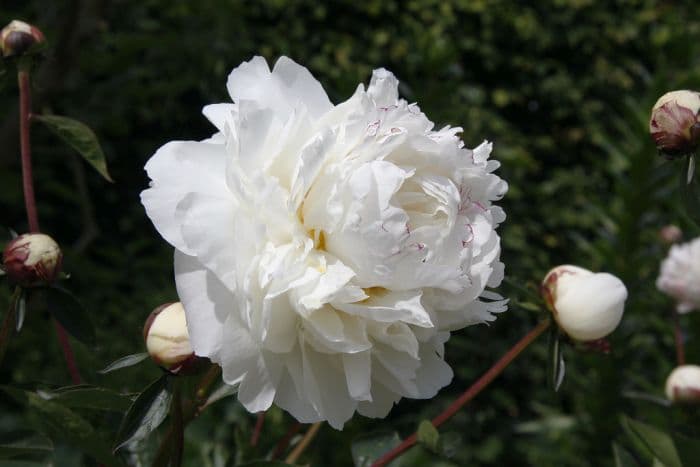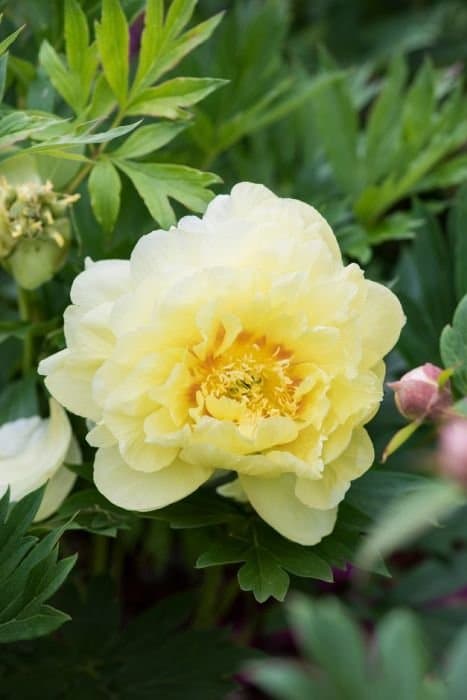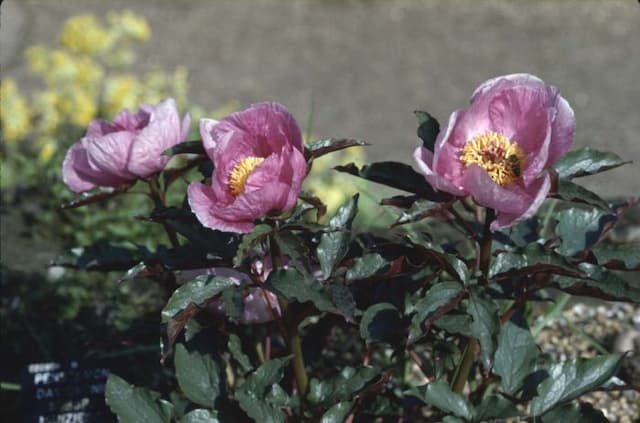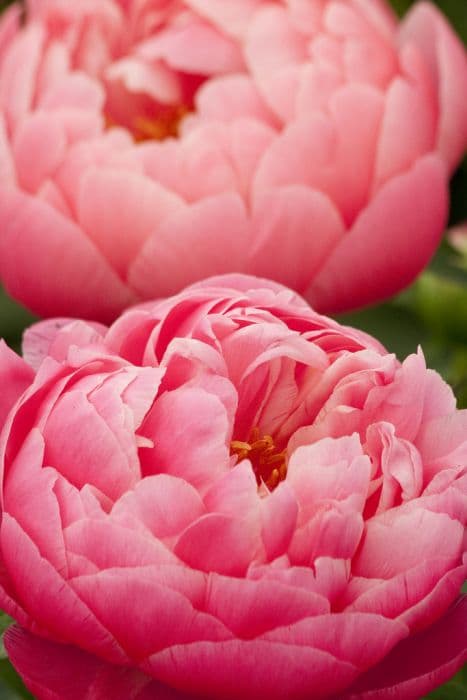Peony Paeonia lactiflora 'Festiva Maxima'

ABOUT
Paeonia lactiflora 'Festiva Maxima', popularly known as the peony 'Festiva Maxima', is a perennial plant with a strikingly lush and ornamental appearance. It is renowned for its large, double flowers that exhibit a pure white hue with occasional flecks of crimson at the center. These flamboyant blooms possess a captivating fragrance that is loved by many garden aficionados. The foliage of this peony variety is a glossy, deep green, forming an attractive mound that serves as a backdrop to the dramatic blossoms. The leaves are divided into leaflets, which are in turn lobed or divided, creating a textured and lush look in the garden. 'Festiva Maxima' blooms in late spring to early summer, providing a showy display that lasts for a short but brilliant period. The striking flowers are supported by sturdy stems, making them excellent for cut-flower arrangements, where their beauty and scent can be enjoyed up close. Overall, 'Festiva Maxima' is a variety known for its timeless elegance in any garden setting, captivating onlookers with its large, white blossoms and their contrasting crimson markings, as well as its vibrant green foliage. It is a classic choice for gardeners seeking to add a touch of romantic charm to their landscapes.
About this plant
 Names
NamesFamily
Paeoniaceae
Synonyms
Chinese Peony, Common Garden Peony, White Peony
Common names
Paeonia lactiflora 'Festiva Maxima'.
 Toxicity
ToxicityTo humans
Peony (Paeonia lactiflora 'Festiva Maxima') is generally considered non-toxic to humans. There is no widespread report of serious toxicity in humans following ingestion of peonies. However, as with many plants, it is possible for some individuals to experience mild gastrointestinal upset if ingested in large amounts, or skin irritation if sensitive individuals handle the plant extensively.
To pets
Peony (Paeonia lactiflora 'Festiva Maxima') is considered to be mildly toxic to pets, such as cats and dogs, if ingested. The main symptoms of peony poisoning in pets can include vomiting, diarrhea, and drooling. Contact with the plant can sometimes cause skin irritation as well. Consumption of large quantities may lead to more serious gastrointestinal upset and should prompt a visit to a veterinarian.
 Characteristics
CharacteristicsLife cycle
Perennials
Foliage type
Deciduous
Color of leaves
Green
Flower color
White
Height
2-3 feet (60-90 cm)
Spread
2-3 feet (60-90 cm)
Plant type
Herb
Hardiness zones
3-8
Native area
Asia
Benefits
 General Benefits
General Benefits- Aesthetic Appeal: Paeonia lactiflora 'Festiva Maxima', commonly known as peony 'Festiva Maxima', has large, fragrant, white flowers with occasional crimson flecks that contribute to garden beauty and visual appeal.
- Pollinator Attraction: The blooms attract bees and other pollinators, thereby supporting local ecosystems.
- Longevity: Peonies are known for being long-lived perennials, potentially thriving for decades with proper care.
- Seasonal Interest: They provide spring to early summer blooms, adding seasonal interest to gardens with their lush foliage even after the flowers have faded.
- Cut Flower Use: The attractive flowers are excellent for bouquets and floral arrangements, with a vase life that is appreciated by gardeners and florists alike.
- Low Maintenance: Once established, peonies require minimal maintenance, making them a convenient choice for gardeners of all skill levels.
- Drought Tolerance: Peonies, including the 'Festiva Maxima' variety, are relatively drought-tolerant, reducing the need for frequent watering during dry periods.
- Cold Hardy: They are robust in cold climates, capable of withstanding harsh winters in many regions where other plants might perish.
- Deer Resistance: Peonies are generally resistant to deer, which can help prevent damage to the garden where deer are a common problem.
 Medical Properties
Medical PropertiesThis plant is not used for medical purposes.
 Air-purifying Qualities
Air-purifying QualitiesThis plant is not specifically known for air purifying qualities.
 Other Uses
Other Uses- Potpourri addition: The dried petals of the peony 'Festiva Maxima' can be added to potpourri mixes for a natural fragrance and a splash of color in home decor.
- Natural dye: The petals of 'Festiva Maxima' can be used to create a natural dye for textiles, offering a range of pink hues.
- Garden support: Its sturdy stems can be left in the garden during winter to provide natural support for winter-blooming plants or those that require additional strength against snow.
- Edible flowers: The petals of the peony 'Festiva Maxima' are edible and can be used as a colorful garnish on salads and desserts (ensure they have not been treated with pesticides).
- Art inspiration: The lush blooms serve as inspiration for artists and can be used in flower pressing to create botanical artworks.
- Bookmark crafting: Dried petals can be laminated or pressed within heavy books to create unique, nature-themed bookmarks.
- Floral ice cubes: Freeze smaller petals into ice cubes to create an elegant touch for summer drinks and punch bowls.
- Wedding confetti: Dried and crumbled petals of the peony 'Festiva Maxima' can be used as biodegradable confetti for weddings and celebrations.
- Tablescaping: The full blooms can be floated in shallow bowls of water to create a romantic and elegant centerpiece for special occasions.
- Photography: The distinctive contrast of the pure white petals with occasional crimson flecks makes 'Festiva Maxima' a popular subject for botanical photography.
Interesting Facts
 Feng Shui
Feng ShuiThe Peony is often used in Feng Shui to promote romance and prosperity. It can be placed in the southwest sector of the garden or home to enhance love and marriage luck, and in the southeast for wealth attraction.
 Zodiac Sign Compitability
Zodiac Sign CompitabilityThe Peony is not used in astrology practice.
 Plant Symbolism
Plant Symbolism- Prosperity: The peony, known for its lush and full blooms, is often associated with wealth and good fortune.
- Romance: With its large and fragrant flowers, the peony is seen as a symbol of romantic love and is commonly used in wedding bouquets and decorations.
- Beauty: The striking appearance of the peony's lush petals represents ultimate beauty and elegance.
- Honor: In various cultures, the peony is a symbol of honor and high esteem, representing respect and admiration.
- Good Luck: The peony is believed to bring good luck, making it a popular choice in floral arrangements for new beginnings and celebrations.
- Compassion: The soft and delicate nature of the peony flower may be seen as a symbol of compassion and nurturing.
- Luxury: Because of its lush shape and often deep color saturation, the peony can symbolize opulence and extravagance.
 Water
WaterPeonies, such as the 'Festiva Maxima', should be watered deeply once a week, providing about 1 inch of water each time, which equates to about 0.623 gallons per square foot. Increase watering to twice a week during hot, dry spells. It's important to avoid over-watering as peonies dislike soggy soil. Water at the base of the plant to keep the foliage dry and prevent fungal diseases. In the fall, reduce watering to help the plant prepare for dormancy.
 Light
LightPeonies like 'Festiva Maxima' prefer full sun, which means they should receive at least six hours of direct sunlight daily. They can tolerate light afternoon shade, particularly in hotter climates, but too much shade will reduce blooming. The ideal spot is an open area where the plant can enjoy the morning sun, which helps dry the dew on the leaves and prevents fungal diseases.
 Temperature
TemperatureThe 'Festiva Maxima' peony thrives in a temperature range from 65 to 75 degrees Fahrenheit during the growing season. They can tolerate winter chill down to -20 degrees Fahrenheit, which is necessary for their dormancy and subsequent spring growth. It's essential to avoid placing them in locations where temperature fluctuations are common, as this can impede their growth and flowering.
 Pruning
PruningPrune your 'Festiva Maxima' peony after it finishes blooming to deadhead the spent flowers, which encourages healthy growth and may help promote more blooms the following year. Remove any damaged or diseased foliage during the growing season to maintain plant health. In the fall, once the leaves have turned brown, cut the stems down to about 3 inches above the soil level to prepare the plant for winter and prevent disease.
 Cleaning
CleaningAs needed
 Soil
SoilPeony 'Festiva Maxima' thrives in well-draining soil enriched with organic matter; a mix of two-thirds garden soil and one-third compost or well-rotted manure works well. It prefers a slightly acidic to neutral pH of 6.5-7.0. Ensure the soil is loose and not compacted to allow for proper root growth.
 Repotting
RepottingPeonies such as 'Festiva Maxima' are typically planted in the ground and do not require frequent repotting. If planted in containers, repot every 3 to 4 years or when the container becomes root-bound.
 Humidity & Misting
Humidity & MistingPeony 'Festiva Maxima' is tolerant of a wide range of humidity levels but does not require any special humidity considerations, as it adapts well to the natural outdoor environment.
 Suitable locations
Suitable locationsIndoor
Not ideal for indoor growth; requires chill period.
Outdoor
Plant in full sun, fertile soil, space 3-4 feet apart.
Hardiness zone
3-8 USDA
 Life cycle
Life cycleThe Paeonia lactiflora 'Festiva Maxima', commonly known as the Festiva Maxima Peony, begins its life cycle as a dormant root or tuber planted in the fall, which initiates the germination process as the soil warms in spring. The plant then emerges from the soil as a small shoot, which quickly develops into a bushy clump of green leaves, with each stem potentially giving rise to a flower bud. By late spring to early summer, the buds bloom into large, fragrant white flowers with occasional crimson flecks at the base of the petals. After flowering, which lasts for 7-10 days, the plant enters a period of photosynthesis and energy storage, where the leaves gather energy for next year's growth before dying back in the fall. Throughout summer and into fall, the plant slowly retreats underground, with the foliage turning brown and the stems dying back as the plant enters dormancy. The root system overwinters beneath the soil surface, storing the necessary energy to begin the cycle anew the following spring.
 Propogation
PropogationPropogation time
Early Fall
The Paeonia lactiflora 'Festiva Maxima' or more commonly known as the peony can be effectively propagated by division, which is the most popular method for this perennial plant. Propagation by division is best carried out in the fall, after the plants have flowered and as they are beginning to go dormant. To propagate by division, gardeners should carefully dig up the peony plant, shaking off excess soil to reveal the root structure. The root clump should then be divided into sections, ensuring that each section has at least 3-5 eyes, which are the buds from which new stems will grow the following spring. The new divisions should be planted immediately, with the eyes no more than 1-2 inches (2.5-5 cm) below the surface of the soil, and spaced about three feet (approximately 91 cm) apart to allow for adequate air circulation and growth. It is crucial to water the newly planted divisions thoroughly to help establish them. This method of division helps to invigorate older plants as well as to increase the number of plants in your garden.









